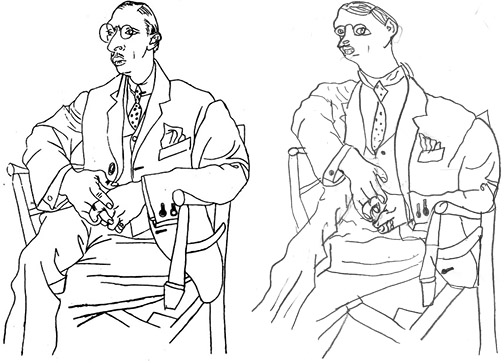(Image: Drawing from upside-down reference. (Left) Reference: Picasso’s Stravinsky, (Right) Student Drawing)
I’ve volunteered as a teaching artist in the Mariposa School System for the Mariposa County Arts Council this year. I’m teaching art to two 5th grade glasses, one hour a week, over twelve weeks. I’m a little more than halfway through the session right now.
I started them off with several right brain drawing exercises: the dual human profiles that create a vase in negative space, drawing a complex image, while viewing it upside down, contour drawing without looking at your paper, etc. (one of my high school art teachers, Betty Edwards, actually wrote the book on right brain drawing techniques). Enough for them to gain a glimpse of what it feels like to draw in the right brain zone, as a seasoned artist does. Few of them could stay in the zone long, so in a short time, during every session, the buzz of talking would rise and I’d have to focus them once again, reminding them that they couldn’t be working in the right brain and talking at the same time. The left brain handles all communication. The right brain is incapable of conversation.
We soon moved on to single point (vanishing point) perspective, discussions of the events and developments that triggered the transition from representational art to abstract art, systems utilized in abstract art, actual painting using these systems and last week, team work on a large collaborative painting (the most fun, so far).
Working with these individuals, about to transition into adolescence, has been a joy and eye opening. In these two classes of 24 to 30 students each, only a small percentage, 2 or 3 students per class, show a focused interest in art. I’m guessing this aligns with the percentage of our society, as a whole, that shares this level of interest. Naturally, these students of focused interest also show the most potential (also a likely reflection of society).
More than this, to some degree, the art exercises reveal the personalities and psychological states of the students. The whole class appears to truly enjoy learning about and participating in art, but a couple students have difficulty following instructions, others ignore the exercise and draw or paint what they want, one or two ask a lot questions, a couple are insecure about whether they are doing things properly, another seeks precision, there are a couple of clowns, one does not participate and another’s actions reveal them to be working out some problems.
I wonder if exercises in other subjects reveal similar things, if the same students exhibit the same behaviors consistently across all subjects or if students respond differently to each subject? Makes me wish I had more time with these kids. Would love to see who each of these individuals becomes in the future.

